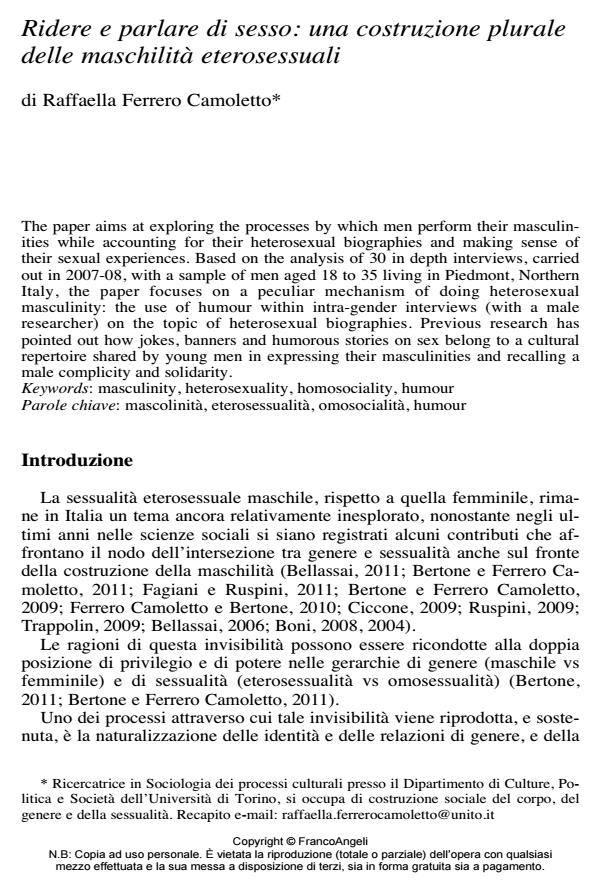Ridere e parlare di sesso: una costruzione plurale delle maschilità eterosessuali
Journal title SALUTE E SOCIETÀ
Author/s Camoletto Raffaella Ferrero
Publishing Year 2013 Issue 2013/2
Language Italian Pages 18 P. 59-76 File size 120 KB
DOI 10.3280/SES2013-002004
DOI is like a bar code for intellectual property: to have more infomation
click here
Below, you can see the article first page
If you want to buy this article in PDF format, you can do it, following the instructions to buy download credits

FrancoAngeli is member of Publishers International Linking Association, Inc (PILA), a not-for-profit association which run the CrossRef service enabling links to and from online scholarly content.
The paper aims at exploring the processes by which men perform their masculinities while accounting for their heterosexual biographies and making sense of their sexual experiences. Based on the analysis of 30 in depth interviews, carried out in 2007-08, with a sample of men aged 18 to 35 living in Piedmont, Northern Italy, the paper focuses on a peculiar mechanism of doing heterosexual masculinity: the use of humour within intra-gender interviews (with a male researcher) on the topic of heterosexual biographies. Previous research has pointed out how jokes, banners and humorous stories on sex belong to a cultural repertoire shared by young men in expressing their masculinities and recalling a male complicity and solidarity.
Keywords: Masculinity, heterosexuality, homosociality, humour
- “A Cathartic Moment in a Man’s Life”: Homosociality and Gendered Fun on the Puttan Tour Isabel Crowhurst, Adam Eldridge, in Men and Masculinities /2020 pp.170
DOI: 10.1177/1097184X18766578 - Men, masculinities and diabetes: ‘doing gender’ in Italian men’s narratives of chronic illness Valeria Quaglia, in Sociology of Health & Illness /2020 pp.1902
DOI: 10.1111/1467-9566.13176 - Handbook of Research on Advanced Research Methodologies for a Digital Society Giuseppe Masullo, Angela Delli Paoli, Sara Tomasiello, pp.764 (ISBN:9781799884736)
- Gender issues for Italian young people: exploring gender identity and cultures in social autobiographies Gaia Peruzzi, Vittoria Bernardini, Raffaele Lombardi, in Journal of Youth Studies /2023 pp.507
DOI: 10.1080/13676261.2021.2022107 - Rivisitare la pratica femminista del ‘partire da sé’: autofiction al maschile e femminicidio inLa scuola cattolicadi Edoardo Albinati Nicoletta Mandolini, in Romance Studies /2019 pp.171
DOI: 10.1080/02639904.2019.1690790 - “Do You Guys Take Showers with Your Children?”: Gendered Embodiment and the Legitimation of Italian Fathering Practices Eugenia Mercuri, in Men and Masculinities /2021 pp.289
DOI: 10.1177/1097184X20976722
Camoletto Raffaella Ferrero, Ridere e parlare di sesso: una costruzione plurale delle maschilità eterosessuali in "SALUTE E SOCIETÀ" 2/2013, pp 59-76, DOI: 10.3280/SES2013-002004